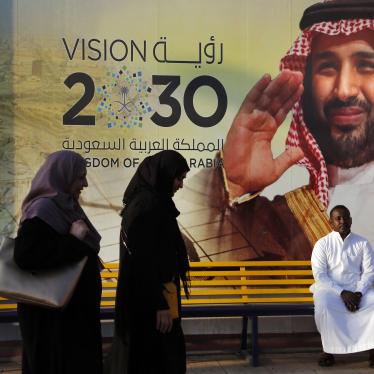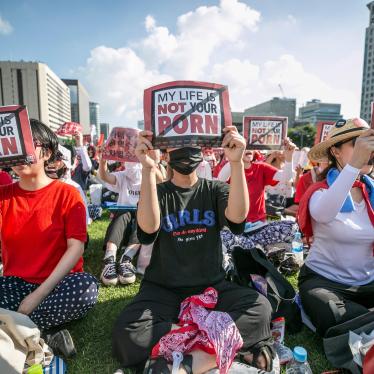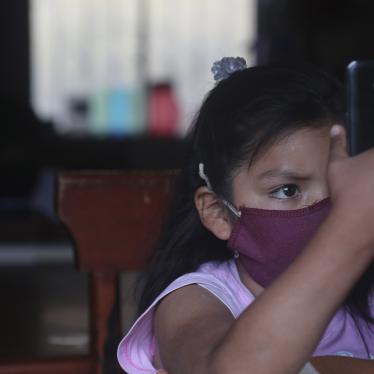(Tripoli) – Libyan authorities should conduct an independent investigation into the quelling of a prison protest in which at least 19 inmates sustained gunshot or shrapnel wounds. The protest took place on August 26, 2013, at Tripoli Main Corrections and Rehabilitation Institution, known by its former name al-Roueimy, where around 500 detainees, including five women, were being held.
Government and prison authorities and 20 inmates interviewed by Human Rights Watch gave conflicting accounts of what occurred at the facility in Tripoli when a two-day hunger strike by detainees sparked a violent confrontation with guards at the jail. As backup, authorities called members of the Supreme Security Committee, a body of former anti-Gaddafi fighters with a mandate to conduct policing and nominally under the Ministry of Interior.
“The government needs to establish what happened on August 26 and explain how so many prisoners had gunshot wounds and other serious injuries,” said Joe Stork, acting Middle East and North Africa director at Human Rights Watch. “Anyone found to have used unlawful violence against prisoners should be held to account under Libya’s criminal law.”
Al-Roueimy prison is under the formal authority of the Ministry of Justice and holds detainees related to the 2011 uprising that ousted former strongman Muammar Gaddafi. The “security” detainees include loyalists of the former government, members of Gaddafi’s security forces and volunteers who fought alongside these forces.
Following the violence on August 26, authorities moved around 150 of the detainees to the adjacent Ayn Zara prison, also administered by the Ministry of Justice. Human Rights Watch spoke to 20 of those prisoners on August 29, both individually and in groups.
Inmates accused al-Roueimy prison authorities of using extensive and unnecessary violence to force an end to the two-day hunger strike by detainees. They gave consistent accounts. They said the hunger strike was to protest their prolonged detention without access to a judge or any legal procedures.
All detainees interviewed by Human Rights Watch said security forces at the prison resorted first to the use of firearms, including automatic weapons, after discussions on ending the hunger strike broke down, before using tear gas as a secondary measure.
One detainee told Human Rights Watch how the negotiations broke down around 4 p.m. and arguments began between the protesters and guards. “This led to heated shouting matches and ultimately one guard opened fire on us with a Kalashnikov,” he said. “I saw one inmate hit the ground after being shot in the thigh. He was bleeding profusely.”
The detainee said the shooting sparked other prisoners to break down cell doors and set fire to mattresses. The guards responded by opening fire with automatic weapons over the next four hours, at times directly at prisoners, he and other detainees said.
Senior officials of al-Roueimy prison gave Human Rights Watch a different version of events. Acting prison director Ali al-Saadi and former director Haitham Beitelmal said they had faced a “mutiny” by around 150 inmates, which spread to all sections of the prison. They said guards at first used tear gas and then fired only rubber bullets over prisoners’ heads “to scare them”. They said four prison officers sustained minor injuries and that prison authorities had launched an internal investigation into the events.
On August 26, the spokesperson for the judicial police, which runs justice ministry prisons, told a press conference that security forces had quelled the prisoners’ protest “peacefully.” He said security forces had used only nonlethal means, including “smoke bombs, water cannons and tear gas,” and had caused no casualties. “Not a single shot was fired at the protesters,” he said, while suggesting that most prisoners’ injuries were due to a “stampede.”
Minister of Justice Salah al-Marghani acknowledged to Human Rights Watch on August 31 that authorities had been slow to address weaknesses in prison security and that untrained and improperly equipped guards may have contributed to the escalation of violence. “We were slower than we should have been in providing nonlethal weapons to the prison authorities,” he said.
Eight of the 20 detainees interviewed by Human Rights Watch sustained bullet wounds in their arms or legs, including two from whom the bullets were yet to be extracted. At least 19 inmates had injuries that they said were caused by shrapnel from ricocheting gunfire, which was confirmed by the clinic sources, suggesting arbitrary shooting of live ammunition by guards into areas occupied by detainees. Most had sustained injuries to their legs or arms, although one received a head wound.
Sources at the Ayn Zara prison clinic, which treated inmates injured in the al-Roueimy prison violence, confirmed to Human Rights Watch that some of those admitted had sustained direct gunshot wounds and others had injuries apparently caused by fragments from ricocheting bullets.
“The government should also address inmates’ underlying grievances about their prolonged detention without charge and lack of access to lawyers,” Stork said.
Accounts from Witnesses
Human Rights Watch is withholding the identity of the inmates whose interviews are cited below to safeguard them against possible reprisals.
One inmate told Human Rights Watch that detainees began a peaceful hunger strike on August 24 to protest their prolonged incarceration in breach of judicial procedures. Prison authorities, he said, had repeatedly told detainees that they would be taken before a prosecutor to commence legal procedures, yet: “Some of us have been detained for two years without any formal charge or seeing a judge even once, so, we decided to go on strike.”
Inmates said that the authorities had tried to convince them to end the hunger strike before resorting quickly to lethal force, including shooting with firearms, at about 4 p.m. on August 26. They said the shooting continued for four hours.
One inmate who said he was in a hallway together with other detainees when the violence began told Human Rights Watch:
The situation inside the prison escalated when prison authorities started to insult detainees. This led to heated shouting matches and ultimately one guard opened fire on us with a Kalashnikov. I saw one inmate hit the ground after being shot in the thigh. He was bleeding profusely. Another detainee rushed to carry him out of harm’s way and this is when tension reached a boiling point.
News spread fast that this inmate was fatally injured [which was untrue] so detainees started to break doors of cells and burn personal belongings and mattresses to try and create a thick smoke that would shield us from the ever intensifying onslaught of security forces. They were shooting directly at us through the metal bars and through the barred ceiling of the corridors and courts. I saw guards of the prison, but they were joined with some men wearing masks.
Only after shooting was “well underway,” the inmate said, guards began to throw tear gas into the cells and courtyards. Inmates allowed a prison official and some guards who had become trapped to escape safely, but firing by guards continued: “until the prison director and some other men from Ayn Zara prison arrived and intervened.”
One inmate who sustained gunshot injuries told Human Rights Watch that prison guards handcuffed and beat him and other wounded detainees as they were evacuated to the clinic at Ayn Zara prison.
Inmates told Human Rights Watch that security forces used several types of firearms, including Kalashnikov assault rifles and 9 mm shotguns, and drove 14.5 mm caliber anti-aircraft weapons into the prison courtyard to intimidate them.
One female inmate told Human Rights Watch that the section of the prison in which she was held saw no violence but was affected by the tear gas. “Prison authorities seemed overwhelmed and did not know what to do,” she said. “We stayed inside our section the whole day, we did not even open the door to get our lunch, we were too afraid.”
Prison authorities told Human Rights Watch that they called in additional security forces to secure the “outside perimeters of the prison” but denied that anyone other than judicial police officers entered the facility or were involved in quelling the protest. They insisted that officers did not shoot directly at detainees and used only rubber-coated bullets once tear gas had failed to disperse the protesting prisoners.
Arbitrary Detention and Ill-treatment
All of the inmates that Human Rights Watch interviewed pointed to a lack of judicial reviews or other legal procedures to resolve their cases as the principal cause of the hunger strike. One detainee from Sirte said that he had been detained since August 23, 2011 but had yet to be taken before a judge or to be informed of any charges against him.
Anyone who is detained without prompt judicial review is a victim of arbitrary detention. The UN Human Rights Committee has stated that the right to judicial review of detention is a fundamental right that cannot be removed even during an emergency. The Libyan authorities should ensure that all detainees are promptly brought before a judge or judicial body to review the legality of their detention. If their detention is not lawfully justified, they should be released immediately. Only those against whom there is evidence of their involvement in committing crimes should be charged, Human Rights Watch said.
Some of the inmates who spoke to Human Rights Watch complained of ill-treatment by guards at al-Roueimy prison prior to the protest. They alleged that guards had threatened detainees with dogs for minor breaches such as smoking cigarettes. One inmate exposed his back to show what he said were welt marks he had sustained during beatings by prison guards. Others accused guards of threatening and insulting prisoners, particularly with the “honor” of their female relatives.
Background on Detention Facilities
Libyan authorities have struggled to maintain security at state-run detention facilities, against a background of repeated mass escapes. In March 2013, some 50 inmates escaped from Sebha prison in southern Libya, followed by the escape of 170 more in April, after a riot at the prison. In July, more than 1,200 detainees escaped from al-Kuweifiah prison during riots in Benghazi. In August, armed men secured the escape of 18 detainees when they attacked the convoy taking them from prison to a court in Tripoli.
In his meeting with Human Rights Watch, Justice Minister Salah al-Marghani voiced concern about general security conditions and the possibility of further violence in prisons. As key constraints he cited the lack of judicial procedures, weak safeguards for detainees, lawyers and judges, and poor training and the lack of equipment for the judicial police. He said his ministry was creating a special force of 1,000 highly trained judicial police officers to oversee the security of detention facilities and to counter escalating tensions but such changes required time and “events are overtaking us.”
Legal Standards
All detainees should be charged or released within a reasonable time. All those facing criminal charges have the right to be informed of the nature and cause of each charge against them and be brought promptly before a judge.
Arbitrary detention is strictly prohibited under international law. Arbitrary detention can amount to a crime against humanity if it is widespread or systematic, and carried out as the policy of the state, or the policy of an organized group such as a militia.
Security forces, including prison guards, should abide by the United Nations Basic Principles on the Use of Force and Firearms by Law Enforcement Officials, Human Rights Watch said. The principles call upon law enforcement officials to “minimize damage and injury, and respect and preserve human life” and to use lethal force only when strictly unavoidable in order to protect life:
Principle 15: Law enforcement officials, in their relations with persons in custody or detention, shall not use force, except when strictly necessary for the maintenance of security and order within the institution, or when personal safety is threatened.
Principle 16: Law enforcement officials, in their relations with persons in custody or detention, shall not use firearms, except in self-defence or in the defence of others against the immediate threat of death or serious injury, or when strictly necessary to prevent the escape of a person in custody or detention presenting the danger referred to in principle 9.
The Basic Principles require governments to ensure an effective review process is available on possible unlawful use of force or firearms by law enforcement officials, and that independent administrative or prosecutorial authorities are in a position to exercise jurisdiction in appropriate circumstances.








